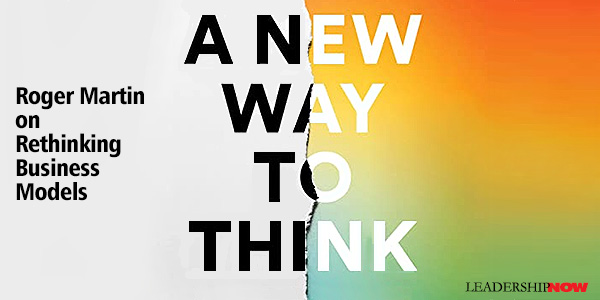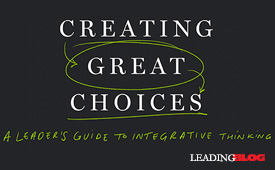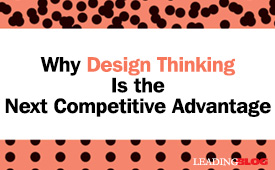A New Way to Think

A BUSINESS MODEL reflects the way we think a business works. They shape how we conduct business. We have models related to all business activities, from production, pricing, and selling to how we motivate, hire, and manage. Every business model is based on assumptions that, too often, we don’t make explicit. And that’s where we can get into trouble.
Roger Martin reports in A New Way to Think that when a model—“a given framework, general practice, theory, or way of thinking”—doesn’t seem to be working, we simply double-down on it and try to execute better. “If making execution a priority doesn’t result in better execution, make execution still more of a priority. If your culture doesn’t change in the direction you want, then mandate culture change even more aggressively.”
“The models are extraordinarily persistent in the face of ineffectiveness and that is because our use of models to organize our thinking and action is so automatic.” So, we never rethink it. When Martin has been asked to help figure out why something isn’t working as well as the CEO wishes, he says, “It has become clear to me over the years that in nearly every case, the poor results weren’t down to their not working diligently enough in pursuit of their goals, it was because the model that guided their actions wasn’t up to the task.”
In 14 self-contained chapters, Martin compares a dominant but often flawed model with an alternative that he believes is more effective and based on better assumptions. He states, “One should always use the best model available, but watch closely to see whether it produces the outcomes that it promised,” he writes. “If it does, keep using it. If it doesn’t, then you should work on creating a better model — one that produces results more in keeping with your goals.” All of the now dominant models make sense and have been used for obvious reasons, but they need to be re-evaluated from time to time.
Each topic reveals the underlying assumptions of old and new ways of thinking:
1. Competition
New model assumption: It happens at the front line, not at the head office. Leading businesses needs to be seen less as a challenge of managing organizational complexity and more about making sure that value is maximized at the front lines.
2. Stakeholders
New model assumption: To actually create shareholder value, put customers before shareholders. A single-minded focus on profits guarantees you won’t get them.
3. Customers
New model assumption: The familiar solution usually trumps the perfect one. Sustained performance is achieved not by always offering customers the perfect choice but, rather by offering them the easy one.
4. Strategy
In strategy, what counts is what would have to be true—not what is true. Developing a winning strategy involves the creation and testing of novel cause-effect hypotheses and the identification of what must be different about the world for those hypotheses to work.
5. Data
Creating great choices requires imagination more than data. You can’t chart a course for the future or bring about change merely by analyzing history. The behavior of customers will never be transformed by a product whose design is based on an analysis of their past behavior.
6. Culture
You can only change it by altering how individuals work with one another. For a culture to align with changes to the formal mechanisms of the organization, changes are required in the way members of the organization interact. The culture only changes if enough people start behaving differently and the new norm gets internalized. Culture depends not on systems and processes or a leader’s beliefs but on how individuals react to each other in the context of their rules and relationships.
7. Knowledge Work
You must organize around projects, not jobs. Knowledge work actually comes primarily in the form of projects, not routine daily tasks. When entire workforces are organized around permanent, full-time jobs, it is difficult to redeploy resources to extremely busy areas to deal with peak demand. [Thus creating the] binge-and-purge cycles of hiring and firing knowledge workers.
8. Corporate Functions
Give them their own strategies. Functions do not have to be servants to corporate overlords, nor should they be petty tyrants building their own empires. Like their business-unit counterparts, functions can use strategy to guide and align their actions, to more effectively allocate resources, and to dramatically enhance the competitive value they provide.
9. Planning
Recognize that it’s no substitute for strategy. If a company is completely comfortable with its choices, it’s at risk of missing important changes in its environment. Human nature being what it is, planning and other activities will always dominate strategy rather than serve it—unless a conscious effort is made to prevent that.
10. Execution
Accept that is the same thing as strategy. You cannot talk about execution separately from strategy. The doctrine that execution is the key to a strategy’s success is as flawed as it is popular.
11. Talent
Feeling special is more important than compensation. When it comes to managing high-end talent. the secret to success is making people feel like valued individuals, not as members of a group, no matter how elite.
12. Innovation
The design of the innovation is as critical as the innovation itself. If you approach large-scale change as two simultaneous and parallel challenges—the design of the artifact in question and the design of the intervention that brings it to life—you can increase the chances that it will take hold.
13. Capital Investment
Assume that its value is reset as soon as it is embedded. Treat an asset as what it is worth immediately after conversion from unfettered to embedded capital...and calculate its ROI based on that embedded value.
14. Mergers & Acquisitions
You need to give value to get value. Companies that focus on what they are going to get from an acquisition are less likely to succeed than those that focus on what they have to give it. The secret is to stop thinking about acquisitions as if targets were jewels to be mined.
As each chapter is a self-contained real-world story, it allows you to skip to subjects of interest. In that way, it is a management handbook that you can return to again and again according to your circumstances.
* * *

Follow us on
Instagram and
Twitter for additional leadership and personal development ideas.
* * *




Posted by Michael McKinney at 06:36 AM
Permalink
| Comments (0)
| This post is about Problem Solving










